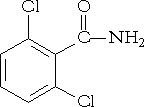|
Evaluation of health hazards by exposure to BAM (2,6-Dichlorobenzamide) and risk characterisation of drinking water exposure 1 General description1.1 Identity 1.1 Identity
1.2 Physical / chemical properties
1.3 Production and useBAM is a soil metabolite of the herbicides chlorthiamid (2,6-dichlorothiobenzamide) and dichlobenil (2,6-dichlorobenzonitrile), which were on the Danish market in the periods 1965 – 1980 and 1970 – 1996, respectively (Clausen et al., 2002, Elkjær et al., 2002). There are no records on industrial preparation or use of BAM. Formerly, it may have been used in the synthesis of dichlobenil (HSDB, 2002). Chemical suppliers market the compound for research and development purposes only. 1.4 Environmental occurrenceIn recent investigations dichlobenil was found in soil samples in more than half of the investigated sites in concentrations of typically up to 100 µg dichlobenil/kg soil (Elkjær et al., 2002). Small amounts of BAM were also detected. As it is assumed that the dichlobenil (and chlorthiamid) have not been used since 1997, this indicates that dichlobenil is still degraded and that BAM continues to infiltrate from the surface. During the period 1992-2001 BAM was found in 22 % of all water samples analysed for BAM from water supply wells (Jørgensen, 2002). The threshold limit for pesticides in drinking water (0.1 µg/l) had been exceeded in 7.2 % of the cases. The mean and median concentration was 0.318 and 0.040 µg/l, respectively, and the highest concentration detected was 560 µg/l. A recent study concluded that in 2002 BAM was encountered in 34 – 38 % of small water supply wells in four Danish counties (Brüsch, 2002). The highest concentration encountered was 14 µg/l. 1.5 Environmental fateBAM is the major metabolite of dichlobenil. If released to air, an estimated vapour pressure of 3.3 x 10-5 mm Hg at 25 °C indicates BAM will exist in both the vapour and particulate phases in the ambient atmosphere (HSDB, 2002). Vapour-phase BAM will be degraded in the atmosphere by reaction with photochemically produced hydroxyl radicals; the half-life for this reaction in air is estimated to be 5.6 days. Particulate-phase BAM will be removed from the atmosphere by wet and dry deposition. If released to soil, BAM is expected to have very high mobility based upon a Koc of 30 (HSDB, 2002). Thus, BAM is expected to leach into groundwater through soil, and this has been confirmed in samples from water supply wells analysed for BAM (Jørgensen, 2002). Volatilization of BAM from moist soil surfaces is not expected to be an important fate process based upon an estimated Henry's Law constant of 1.2 x 10-9 (atm x m³)/mole (HSDB, 2002). Using a soil grab sample, 0.4%, 0.9%, 3%, and 6.1% of BAM (initial concentration 1 mg/l) degraded after 4, 12, 51, and 110 days of incubation, respectively, which suggests that BAM does not biodegrade rapidly in soil (HSDB, 2002). If released into water, BAM is not expected to adsorb to suspended solids and sediment based upon the Koc (HSDB, 2002). A BCF of 10 for Golden Ide fish suggests that bioconcentration in aquatic organisms is low (HSDB, 2002). BAM does not biodegrade rapidly in water (HSDB, 2002). Hydrolysis is not expected to occur due to the slow rate of reaction for amide functional groups. 1.6 Human exposureOccupational exposure to BAM may have occurred through inhalation and dermal contact with this compound at workplaces where BAM was produced or used (HSDB, 2002). Ingestion of food and drinking water containing BAM is considered the most relevant source of exposure for the general population (HSDB, 2002). Potential residues of dichlobenil in food crops, e.g. from imported fruits, are not likely and will not contribute to BAM exposure, as dichlobenil is not converted to BAM in vivo. Residues of BAM in imported fruit from herbicide treated orchards are theoretically possible but are considered to be insignificant, because of the limited use of dichlobenil on edible crops. No analytical data are available because the Danish Veterinary and Food Administration (DVFA) does not analyse for BAM or dichlobenil during their routine inspection for residues of pesticides. Dermal exposure to BAM contaminated drinking water (e.g. by taking a bath) is a possible route of exposure. Although no information is available on dermal absorption of BAM, the dermal contribution of bioavailable BAM is considered insignificant compared to that of the oral route. DermWin v1.42 is a model, which estimates the dermal permeability coefficient and uptake (U.S.Environmental Protection Agency, 2000). If the water contains 500 µg BAM/l, if an adult person weighs 70 kg (equivalent to 1.8 m² surface area), and if a bath takes 15 min, then the theoretical dermal uptake is about 0.015 – 0.09 µg BAM/kg body weight (bw), or about 0.1 – 0.6 % of the oral uptake via drinking water (Table 1). A low vapour pressure indicates a very low risk of inhalation of BAM. Intake of contaminated drinking water is the most relevant route of exposure. Under normal conditions an adult person weighing 70 kg drinks about 2 litres of water every day, i.e. 0.03 l/kg bw/day (Miljøstyrelsen, 1992). Hot weather and high physical activity will increase the intake. For children in the age group 1 – 10 years, a daily water intake of 0.08 l/kg bw/day can be taken as a 95-percentile (U.S.Environmental Protection Agency, 1997). If the water contains 0.1 µg BAM/l, which is the administrative threshold limit in drinking water, the intake 0.003 µg BAM/kg bw/day and 0.008 µg/kg bw/day for adults and children, respectively (see Table 1). Exposure to the highest concentration detected in a recent study, 14 µg/l (Brüsch, 2002), corresponds to an intake of 0.42 µg BAM/kg bw/day and 1.12 µg/kg bw/day for adults and children, respectively. Exposure to the unusual and extremely high concentration detected in the period 1991 – 2001, 560 µg/l (Jørgensen, 2002), corresponds to an intake of 16.8 µg BAM/kg bw/day and 44.8 µg/kg bw/day for adults and children, respectively. Table 1. Theoretical intake of BAM via drinking water
|
